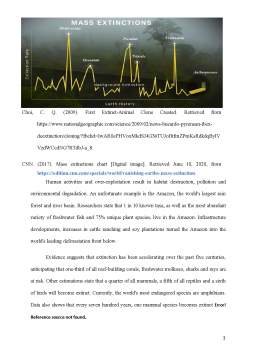Extras din referat
Introduction
Extinction is a concept developed in revolutionary France, due to the discovery of the "Mammut americanum" fragments. It is defined as the eradication of species or entire genus and is a frequent event in geological time (Kolbert, 2014). Current data reveals that 99.9% of all species that have ever lived are now extinct.
Scientists developed several theories to explain extinction. The traditional approach takes into account Darwinian natural selection mechanisms. Yet, researchers find 'evolutionary apoptosis' (Joseph, 2009b) the most accurate hypothesis as it considers genetic mechanisms. However, the scientific community agrees that extreme climate change, global anoxia, cataclysmic events, and disease are planetary factors that account for mass extinctions. Other extraterrestrial factors involve radiation and asteroid collision (Elewa, 2009).
Throughout history, our planet sustained at least five major mass extinctions: Ordovician, Devonian, Permian, Triassic and Cretaceous. Some scientists believe that other mass extinctions occurred during the Paleoproterozoic and Cambrian Eras (Elewa, 2009).
The first mass extinction occurred during the Paleoproterozoic Era, 2.3 to 1.8 billion years ago. The release and breakdown of different gases, as well as biological activity, resulted in extreme climatic conditions, thus affecting billions of microorganisms (Condon et al., 2005).
About 725 to 670 million years ago, the Sturtian glaciation emerged as the second mass extinction by cause of a global ice age (Elewa, 2009). A third global ice age proceeded, known as the Marinoan glaciation, about 640 to 580 million years ago. Volcanic ash and oxygen mixed in the atmosphere, generating glaciations (Condon et al., 2005). Both events affected a significant variety of evolved organisms. The fourth mass extinction occurred about 540 million years ago at the beginning of the Cambrian Era during the Ediacaran period. Yet, these four events are not among the most significant extinctions (Elewa, 2009).
The Ordovician Age marks the first great extinction 510 to 440 million years ago. Scientists consider it as the second most catastrophic event for fauna. Conodonts, graptolites, several reef builders' species and about half of all brachiopod and bryozoans taxa ceased to exist. The primary causes were global cooling and glaciations. Other contributing factors include plate tectonics and continental drift (Elewa, 2009).
The Devonian Age comprised the evolution of bony fish, amphibians, insects as well as new generations of reef species. The extinction occurred 410 to 360 million years ago, as a consequence of bolide impacts. As a result, over 70% of all species perished, forcing the marine ecosystem to restructure itself in its entirety (Elewa, 2009).
Known as the most devastating mass extinction in history, the Premian Extinction annihilated almost 95% of all marine animal species. The phenomenon resulted from meteorite collisions and volcanic eruptions (Benton and Twitchett, 2003), as well as glaciations followed by global warming (Kidder and Worsley, 2004).
Therapsids, pterosaurs as well as the first flying vertebrates began to evolve in the Triassic Era. About 251 to 199 million years ago, asteroid impacts and massive volcanic eruptions led to the extinction of 22% of marine families and almost half of all marine genera (Elewa, 2009).
Bibliografie
Benton, M. J., & Twitchett, R/. J. (2003). How to kill (almost) all life: the end-Permian extinction event. Trends in Ecology & Evolution.
Choi, C. Q. (2009). First Extinct-Animal Clone Created. Retrieved from https://www.nationalgeographic.com/science/2009/02/news-bucardo-pyrenean-ibex-deextinction/cloning/?fbclid=IwAR0ePHVoxMkdSJ4G36TUJoBtfmZPmKsRdkdqBylVVzdWCcdNG7RTdbJ-a_8.
CNN. (2017). Mass extinctions chart [Digital image]. Retrieved June 10, 2020, from https://edition.cnn.com/specials/world/vanishing-earths-mass-extinction.
Condon, D. et al. (2005). U-Pb Ages from the Neoproterozoic Doushantuo Formation, China. Science, vol. 308, pp. 95-98.
Elewa, A. M., & Joseph, R. (2009). The History, Origins, and Causes of Mass Extinctions. Journal of Cosmology, vol. 2, pp. 201-220.
Joseph, R. (2009a). The Evolution of life from other planets. Journal of Cosmology, vol. 1, pp. 100-200.
Joseph, R. (2009b). Extinction, metamorphosis, evolutionary apoptosis, and genetically programmed species mass death. Journal of Cosmology, vol. 2, pp. 235-255.
Kidder, D. L., & Worsley, T. R. (2004). Causes and consequences of extreme Permo-Triassic warming to globally equable climate and relation to the Permo-Triassic extinction and recovery. Palaeogeography, Palaeoclimatology, Palaeoecology, vol. 203, pp. 207-237.
Kolbert, E. (2014). The sixth extinction an unnatural history. New York: Picador, Henry Holt and Company, vol. 1, pp. 27.
Lockwood, R., (2003). Abundance not linked to survival across the end-Cretaceous mass extinction: patterns in North American bivalves. Proceedings of the National Academy of Sciences, USA, vol. 100, pp. 2478-2482.
Manghwar, H., Li, B., Ding, X., Hussain, A., Lindsey, K., Zhang, X., & Jin, S. (2020). CRISPR/Cas Systems in Genome Editing: Methodologies and Tools for sgRNA Design, Off-Target Evaluation, and Strategies to Mitigate Off-Target Effects. Advanced science, vol. 7, pp. 6.
Micklos, D. (2009). DNA Today: The Neanderthal Genome Project - CSHL DNA Learning Center. Retrieved June 13, 2020, from https://dnalc.cshl.edu/resources/dnatoday/090521_neanderthal.html.
Raup, D. M. (1992). Bad genes or bad luck. Norton, New York.
Seeker. (2017). How Close Are We to Resurrecting Extinct Species? [Youtube video]. Retrieved June 14, 2020, from https://www.youtube.com/watch?v=qA1_mdiDgyk
Taylor, P. D. (2004). Extinctions in the history of life. Cambridge: Cambridge University Press, pp. 151-171.
WWF. (2013). Deforestation in the Amazon. Retrieved June 11, 2020, from https://wwf.panda.org/our_work/forests/deforestation_fronts2/deforestation_in_the_amazon/.
Preview document
Conținut arhivă zip
- Extinctia speciilor.docx
















